Kansas City Royals: The complicated legacy of David Glass
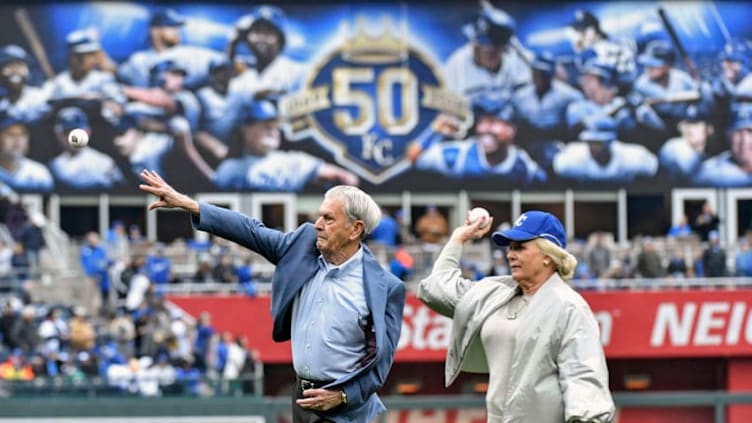
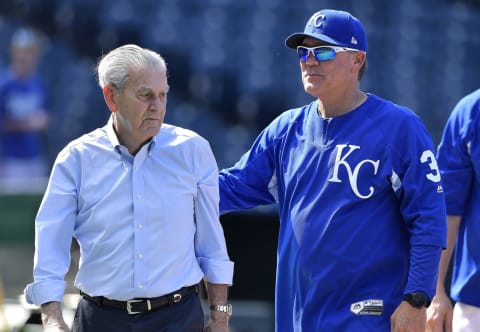
Now that David Glass has agreed to sell the Kansas City Royals, let us look back at his legacy.
Well, it is all but official. After nearly two decades as the owner of the Kansas City Royals, David Glass has sold the team to local businessman John Sherman for $1 billion. While the deal still needs MLB approval, Glass is set to make a tidy profit on his $96 million expenditure to purchase the team.
During his tenure, the Kansas City Royals have had quite the roller coaster ride. They had gone from being one of the model franchises in the game during Ewing Kauffman’s tenure to being a laughingstock, a team that was essentially eliminated from postseason contention when Opening Day came around.
While the Royals typically struggled over the past two decades, Kansas City also reached the mountaintop. They appeared in consecutive World Series, claiming their second championship in 2015. However, the Royals had just four winning seasons since 2000, an unfortunate showing for a team that was once considered one of the best in the game.
Now that David Glass has sold the Kansas City Royals, let us take a look back at his ownership, and his history with the team.
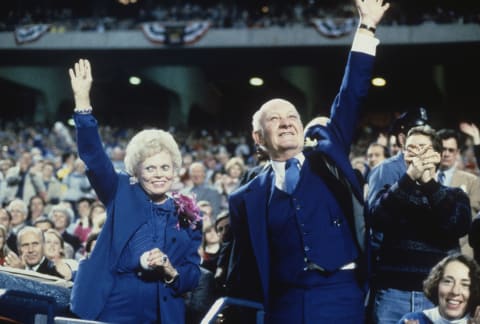
The Kauffman Trust
Ewing Kauffman was simply doing what he felt was right for the Kansas City Royals to keep them in town. The Trust would make sure of that.
David Glass first became a part of the Royals at Kauffman’s passing. He was named the interim CEO and chairman of the team, tasked with keeping the Royals in Kansas City. However, his actions during that time did not exactly endear him to the fanbase.
Glass, who made his money during his time at Wal-Mart, ran the Royals in the same cost cutting fashion. Payroll was slashed from $41 million all the way down to $19 million. The results in the standings were irrelevant – all that mattered was the bottom line and the Royals profit margins. Glass also refused to accept any deal with the Player’s Union during the 1994-95 strike that did not include a hard salary cap, and was a strong proponent of using replacement players during that time.
The Trust also changed the Royals future. Not only did they jettison anyone making any type of money, but they also kept the Royals in the American League. The franchise was the original choice to move to the National League during expansion and realignment, setting up a natural rivalry with the Cardinals. Instead, the Trust did nothing, leaving Major league Baseball to move the Brewers to the NL Central instead.
As it turned out, those moves would work out well for David Glass. After nearly seven years in his “interim” role, he officially purchased the team on April 18, 2000 for $96 million. His offer was actually lower than the $120 million offered by Miles Prentiss, but MLB had questions about Prentiss’ net worth and ability to handle losses. The Kansas City Royals were now his to do whatever he wanted with.
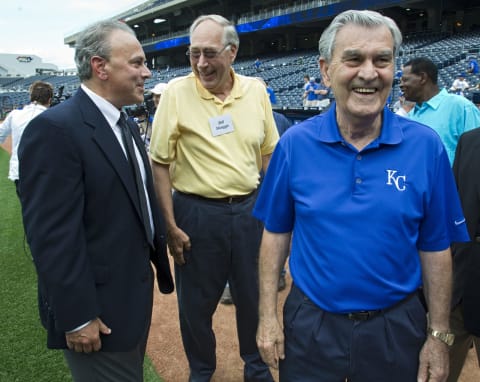
Nothing really changed for the Kansas City Royals
Even with the Kansas City Royals officially belonging to him, David Glass did not change his modus operandi. The Royals continued to struggle on the diamond, and the team continued to ship out virtually anyone making a respectable salary.
Budding stars, such as Jermaine Dye, Carlos Beltran, and Johnny Damon were all sent packing, as was seemingly every player aside from Mike Sweeney. Those deals almost never panned out, with the “top prospects” either fading into nothingness, or becoming decent players at best. However, the Royals were making record profits, which is really all that mattered to Glass.
Yes, the Royals struggled, but there was one outlier. In 2003, despite expectations being in the toilet, the Royals managed to lead the AL Central through August 29. They finished the year with an 83-79 record, their first winning season since the strike shortened 1994 season. Darrell May somehow managed a 5.9 bWAR (his career bWAR total is 5.7), and Tony Pena turned enough miracles to ensure his canonization when he passes.
Aside from that miracle season, the Royals simply remained in a constant state of rebuilding. The biggest move may have come on June 8, 2006, when Dayton Moore was hired as the Royals GM. While he stumbled through the rebuilding process as well, the Royals used their top draft picks and made intelligent trades to help build a contending roster, something that had not been seen for decades. Yes, the early part of the 2010s were a struggle, but there was a light at the end of the tunnel.
Finally, after years of misery, the Kansas City Royals were ready to contend.
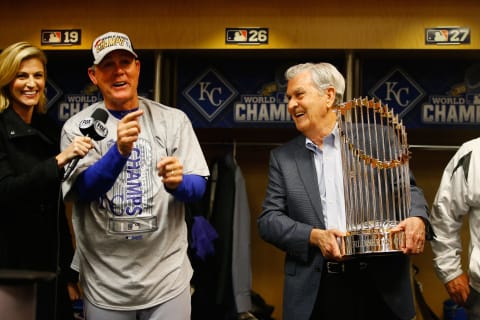
The Kansas City Royals new Golden Era
Well, it took long enough for the Kansas City Royals to succeed. However, in 2013, the first signs that the rebuild was finally over began to appear.
That offseason, Dayton Moore made a move that showed the Royals were ready to mean business. In exchange for Jake Odorizzi, Wil Myers, Mike Montgomery, and minor leaguer Patrick Leonard, the Royals received James Shields, Wade Davis, and Elliott Johnson. Johnson did not last long in Kansas City, and Davis spent most of 2013 in the rotation before becoming a dominant reliever, but the trade signaled a change in philosophy. Kansas City finished the year with an 86-76 record, their first winning season in a decade, and a sign of what was coming.
2014 was a bit of a disappointment during the first half. The Royals were two games under .500 at the trade deadline, leaving the team with a relatively quiet July. However, the Royals got hot down the stretch, earning a Wild Card berth and sweeping their way through the American League side of the postseason. While they finished 90 feet short of the championship due to Madison Bumgarner‘s heroic performance, the Royals were relevant once more.
The 2015 season proved to be magical. The Royals were playing with a chip on their shoulder from the start of the season, exemplified by Yordano Ventura‘s willingness to literally fight anyone. Ventura and Danny Duffy took major steps forward in their development, and the Royals made deals at the deadline to add Johnny Cueto and Ben Zobrist. Once again, the Royals found their way through the AL side of the postseason ladder, using more of their late inning magic to reach the World Series. This time, they were able to finish the job, taking down the Mes in five games to win their first title in 30 years.
It was safe to say that Kansas City was starved for success. 850,000 people showed up to the victory rally in November, a level of support that was truly impressive. The Royals had captured the region, making Kansas City a baseball town once again. However, the good times would not last, despite David Glass doing his best.
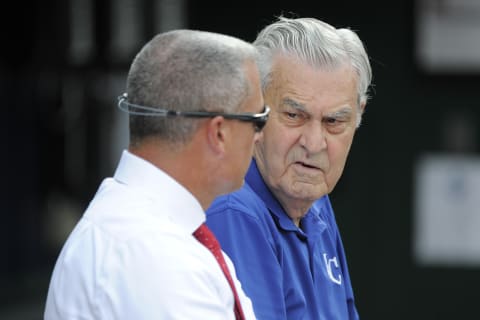
One last gasp before the Kansas City Royals descent
Although Cueto and Zobrist departed in free agency, the Kansas City Royals still intended to contend in 2016. David Glass had opened his checkbook, as Ventura and Duffy had signed long term extensions, and Ian Kenndy was brought in to fill out the rotation. The hope was that the young duo would be able to tap into their potential to be top of the rotation starters, while the focus on defense and contact would work once again.
Unfortunately, the Royals were snakebitten. Mike Moustakas and Alex Gordon collided while tracking a popup at the end of May, costing Moustakas the rest of the season and Gordon a month. The Royals offense just could not produce enough, and the pitching staff took a step back. Edinson Volquez and Chris Young were pummeled with the regression hammer, and the second coming of Joakim Soria was a disaster.
Despite those injuries and general ineffectiveness, the Royals were still able to finish with a .500 record. If they could stay healthy, and rotation could take a step forward, the Royals could have contended in 2017. Instead, tragedy struck before the season, as Ventura was killed in a single car accident in the Dominican Republic on January 22, 2017.
His passing took the wind out of the Royals sails. Jason Hammel was signed to fill his void in the rotation, but the Royals were not the same. In what was to be their last gasp before free agency closed the playoff window, Kansas City just did not have that same passion. Hammel was a disaster, and the Kansas City Royals finished with an 80-82 record. With a large portion of the core heading to free agency, the playoff window was closed.
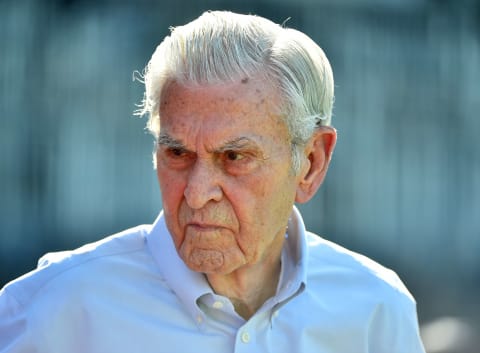
A return to familiar ground for the Kansas City Royals
Over the past two seasons, the Kansas City Royals have once again found themselves in the Major League Baseball cellar. Yet, the blame is not entirely on David Glass.
It would have been easy for the Royals to go back to another rebuilding period without struggle, claiming that they were looking to build another long term contending team with their homegrown talent. And while that has been the case, that option was Plan B.
Instead, the Royals did everything they could to keep the band together. While Lorenzo Cain signed early in free agency, heading to the Milwaukee Brewers on a five year deal, Kansas City tried to keep Eric Hosmer. He was offered an eight year deal worth $100 million, easily the largest in Royals history, before leaving for San Diego. Mike Moustakas did return on a one year deal for 2018, but he was not expected to finish the season in Kansas City.
Indeed, Moustakas was traded to the Brewers at the trade deadline, as the Royals bottomed out. They finished the year with a 58-104 record, their first 100 loss season since the Buddy Bell days in 2006. Only the Orioles finished with a worse record last season, allowing Kansas City the opportunity to select Bobby Witt Jr with the second overall pick of the 2019 MLB Draft.
This season has been more of the same. The Royals were not expected to contend this year, and that has certainly been the case. Heading into Sunday, the Royals have a 48-89 record, better than just the Orioles and the Tigers.
However, better days appear to be ahead. The Royals quartet of pitching prospects – Brady Singer, Jackson Kowar, Daniel Lynch, and Kris Bubik – could all be in the majors by the end of the 2021 season. If they can live up to their potential, the Kansas City Royals could be a force again in the near future. It just will not be one that Glass will be a part of.
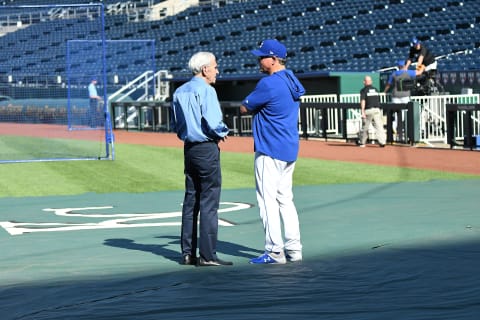
Judging David Glass’ ownership of the Kansas City Royals
The Kansas City Royals have had their ups and downs when David Glass owned the franchise. Yet, he should be judged by more than their record.
More from Call to the Pen
- Philadelphia Phillies, ready for a stretch run, bomb St. Louis Cardinals
- Philadelphia Phillies: The 4 players on the franchise’s Mount Rushmore
- Boston Red Sox fans should be upset over Mookie Betts’ comment
- Analyzing the Boston Red Sox trade for Dave Henderson and Spike Owen
- 2023 MLB postseason likely to have a strange look without Yankees, Red Sox, Cardinals
Yes, he oversaw the Royals return to glory. He opened the vault and gave the goahead for the acquisitions of Wade Davis, Johnny Cueto, and Ben Zobrist, all of which played a key part in their first championship in 30 years. But he also provided far more.
What Glass provided was stability. Dayton Moore has been the general manager since 2006, trailing only Brian Cashman and Jon Daniels in terms of longevity. Ned Yost has been the manager since 2010, the only manager of the Royals to stay with the team through four seasons. While Yost may retire after this season, he is currently the longest tenured manager in the AL, and trails only Bruce Bochy in longevity.
Glass has also changed his ways during his time as owner. He was more willing to open the vault, especially after seeing how the city embraced the Royals during their run of success. While that success has been fleeting in recent seasons, there is hope for the future, which is more than could be said at the beginning of his reign. In the end, the Royals found success, which makes up for the first dozen years.
Next. Royals Mount Rushmore. dark
As David Glass is entering his final days as the owner of the Kansas City Royals, he leaves behind a mixed legacy. He also leaves John Sherman with a team that could be ready to contend in a couple of years, and a fanbase hungry for more success.